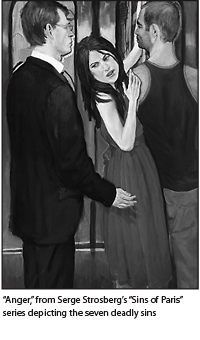By Jan Engoren
STROSBERG,
PARIS-NEW YORK
Through March 30, by appointment
URI Enterprises
515 Broadway, Apt. 4A
(646-861-1690, e-mail urienterprises@gmail.com)
Painter Serge Strosberg has adopted New York as his second home, following in the footsteps of fellow European artists Willem de Kooning and Gaston Lachaise. When opening his U.S. studio, he settled on Soho because of the constant activity on Broadway.
“I feel as if I’m living in a Hopper cityscape painting,” Strosberg said. “New York inspires me.” Originally from Antwerp, Belgium, Strosberg graduated from the Parisian graphics design school L’Académie Julian, where luminaries Gauguin, Bonnard, Matisse, and Léger studied.
Strosberg chose Manhattan because of its dynamic art scene and after less than six months already feels like a New Yorker. “Americans and other nationalities blend in here very easily,” he said. “I always felt like an outsider, even in my country of birth, because of my black hair, dark skin and Sephardim heritage.”
His sense of being an outsider is reflected in his works, which depict people from all walks of life: the seven-feet-tall bouncer as well as the Chinese actress who is at once open and ambivalent. “Young Girl with Piercing” shows a pierced lesbian couple in a modern-day “Le Déjeuner sur L’hérbe” that would surely jolt Manet into the 21st century.
If portraiture captures not only the person, but also the era, Strosberg has illustrated contemporary life in all its guises. Characterized as a mix of expressionist and realist, his style falls outside mainstream traditional British portraiture.
The eyes in his paintings follow the viewer through the room. “I’m searching for the soul,” Strosberg said. “My work is intrusive. It goes beyond representation; my objective is to capture the thoughts and feelings of my subjects in the moment. I’m interested in portraying their expression and translating it directly to the canvas.”
“Painting is the road you take within yourself through another, until you spiritually embrace all that lives and moves in them,” said French art critic Jean-Louis Poitevin. “Looking at his [Strosberg’s] work, you must cover the same ground, and also set off on a voyage of discovery of the unknown person in front of you.”
Poitevin explains, “Serge’s interest in each individual pushes him to try to capture the maximum emotive power of the model without recourse to pictorial artifice, to unlikely poses or brusque gestures. In concentrating on a dense and compact look, he offers a view of the vastness of the other.”
Before deciding to become an artist, Strosberg worked as a chemist, gleaning knowledge he now uses to great effect when mixing pigments. In Europe, he studied with a well-known German craftsman, learning to mix oil with egg tempera and special dyes to create vivid pigments, a method that adds a three-dimensional texture, luminosity, and animation to his portraits.
On display are his latest works, “Sins of Paris,” (“Péchés de Paris”) and his “Métro” series. In the paintings, Strosberg experiments with storyboard-like, cinematography oriented, narrative panels that explore socially relevant topics by featuring the same models throughout. “Sins of Paris” explores the seven deadly sins in a montage, offering contemporary interpretations of each sin.
His paintings of the Paris Métro reveal a graffiti-covered, non-glamorized city, illustrating the loneliness and isolation of its habitants. In one frame we see what could be a self-portrait of the artist, a young man sits meditatively, eyes half-closed, caught in a private reverie, while in the other frames, Strosberg captures a sense of movement and a snapshot of passengers traveling to their destinations.
“I love to paint everyday New Yorkers,” Strosberg said, “janitors, policemen and taxi drivers. My next project will be to translate the ‘Sins of Paris’ into the ‘Sins of New York’ and put a local spin on this ancient theme.”


































